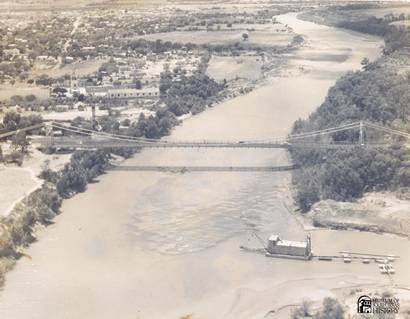|
One
sweltering summer afternoon in July of 1936, patrons of the U.S. Bar
in Reynosa, Mexico
were nursing their beers and tequila, hiding from the afternoon heat,
when a rocket fired from the American side of the Rio Grande River
plowed into the bar under a sign that read: "The Only Beer in Mexico."
The patrons scattered, suspecting maybe an earthquake, revolution
or worse. Some may have sworn off the hard stuff right then and there.
But no one was injured.
The master of all this Mexican mayhem was a 16-year old American boy
named Keith Rumbel, who designed and built the rocket and came up
with the idea of firing it into Mexico, all with the somewhat reluctant
approval of both the Mexican and U.S. governments.
According to a description by historian and writer Brian Robertson,
Keith was "a smooth-faced boy with a dreamy kind of look framed within
wire glasses." He was one of those whiz kids who knew a lot about
a lot of different things because he was interested in a lot of things,
but he loved rockets the most. The Rumbel backyard served as a launching
pad for Keith's many model rockets, which he tethered to a clothesline
to keep them confined to Rumbel family air space.
Oliver Rumbel, Keith's father, was a long-time member of the Loyal
Service Post # 37 of the American Legion. The post was trying to do
something no other American Legion post in the Southwest had yet done
- finance and build its own building. Over dinner one night, Oliver's
precocious and rocket-obsessed son came up with a possibly brilliant
idea - rocket mail delivery!
The idea wasn't entirely new. Europe had been experimenting with transporting
mail by rocket for several years, and the U.S. had also conducted
a few experiments that never amounted to much. But no one had ever
sent mail from one country to another via rocket.
Oliver Rumbel might have said something like, "That's a crazy idea
- so crazy it just might work!" because the Legion soon put the plan
into action. Since this was a historic first, the Legion sold triangular
"rocket stamps" for 50 cents each, or two dollars for a pack of four,
to raise the needed money. As it turned out, Keith Rumbel was as good
with a printing press as he was with rockets. He also designed and
printed the stamps, figuring that one day the stamps would be collectors'
items. |
 |
Aerial view of
Hidalgo, Rio Grande,
Reynosa Bridge crossing
into Mexico.
Photo courtesy Museum of South Texas History |
On
July 2, 1936, members of the Loyal Service American Legion Post #37
along with government officials from both sides of the river gathered
on the American side of the International Bridge at Hidalgo.
The government officials were concerned, as government officials often
are. The plan was to fire five rockets from the U.S. side of the river
into Mexico,
and then go to Mexico and send five rockets onto U.S. soil. This might
be the only time in history that two countries have launched rockets
back and forth at each other for fun and profit.
The Legion's state historian, Garland Adair of Austin,
lit the first rocket. It traveled about a hundred yards before exploding
over the Rio Grande River. Fortunately, Keith and his father had constructed
the rockets of laminated cardboard and fiberboard in case of such
an event. One of the rocket fragments hit a U.S. Customs official
and, as Robertson put it, "ruined a government-issued shirt."
The second missile was the one that scattered the bar patrons in Reynosa.
For a long time afterward the Mexican government insisted on calling
this incident "the U.S. Bar tragedy."
The third rocket took off on a peculiar and unexpected trajectory
of its own and landed on the roof of a small house near the river.
By chance, the house was one of the few in the area with a shingle
roof rather than a thatched one, which could have caused a great fire.
A nearby corn field wasn't so lucky. The last rocket landed there
and set it ablaze.
Then it was time to shoot five rockets from Mexico back at the U.S.
The rockets fired from Mexico traveled from a thousand feet to almost
a mile, all landing on American soil without causing undue damage
or disturbance. A San Antonio
paper reported, "A common sight was that of a puffing Legionnaire
chasing after an urchin who had a letter gripped in his grimy little
hand."
And that was pretty much that.
As for Keith Rumbel, the whiz kid who dreamed this up and helped make
it happen, he left his hometown of Sharyland after high school, graduated
first from Rice University and later the Massachusetts Institute of
Technology. To the surprise of no one who knew him he became a rocket
scientist and helped design a missile called the Terrier for the U.S.
Navy.
However, Rumbel was not involved in June of 1959 when 3,000 letters,
including one written by President Dwight Eisenhower, were fired from
Navy submarine U.S.S. Barbero to a Florida naval station. That was
as far as rocket mail ever went. During the peak years of the Cold
War, the Navy decided its rockets could be put to better use.
Some of the "rocket stamps" and rocket postcards that Rumbel printed
are still in circulation. They go for $50 to $150 online, which is
probably not as much as Rumbel dreamed of as a teenager. But they
remain valuable as a genuine artifact and reminder of the history
he helped make. |
|
|
